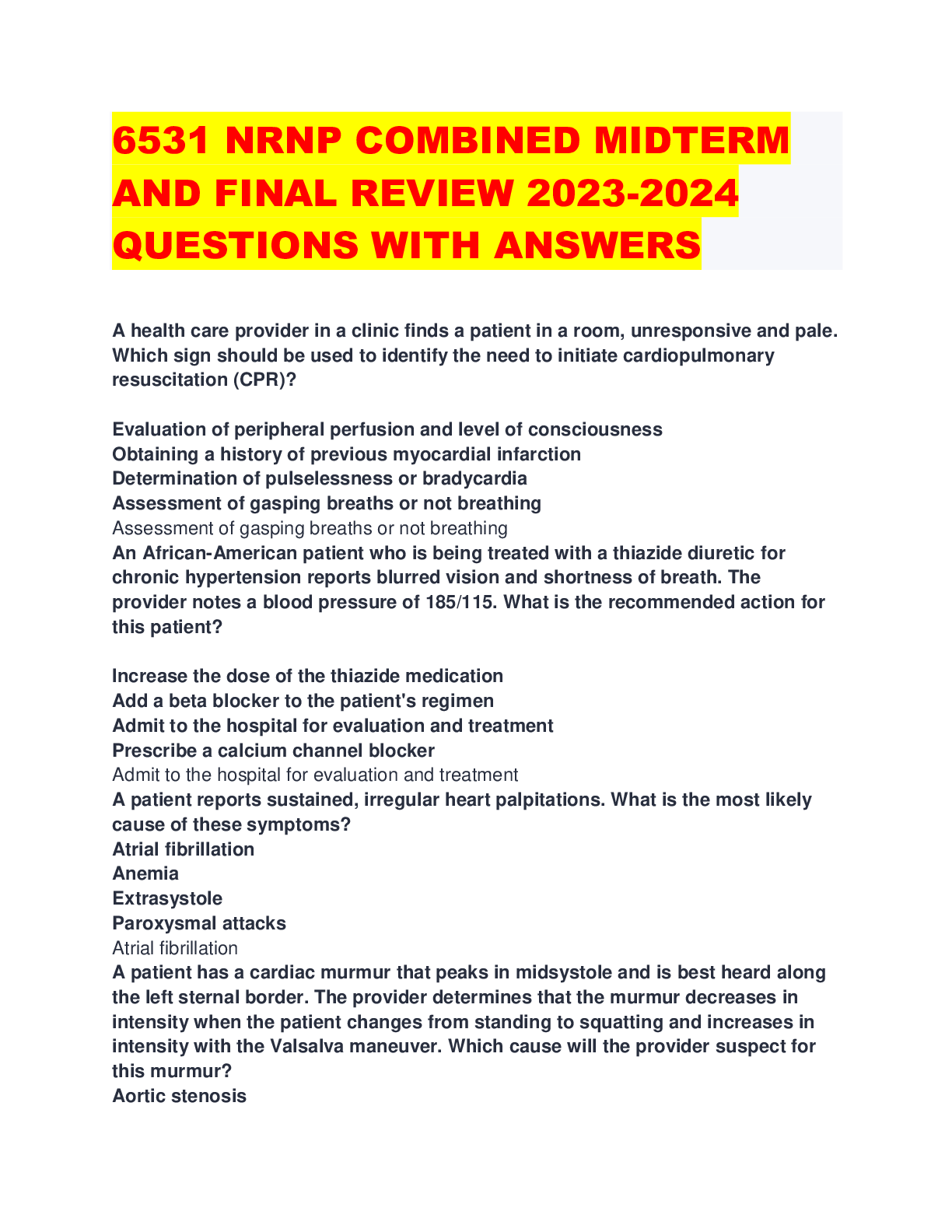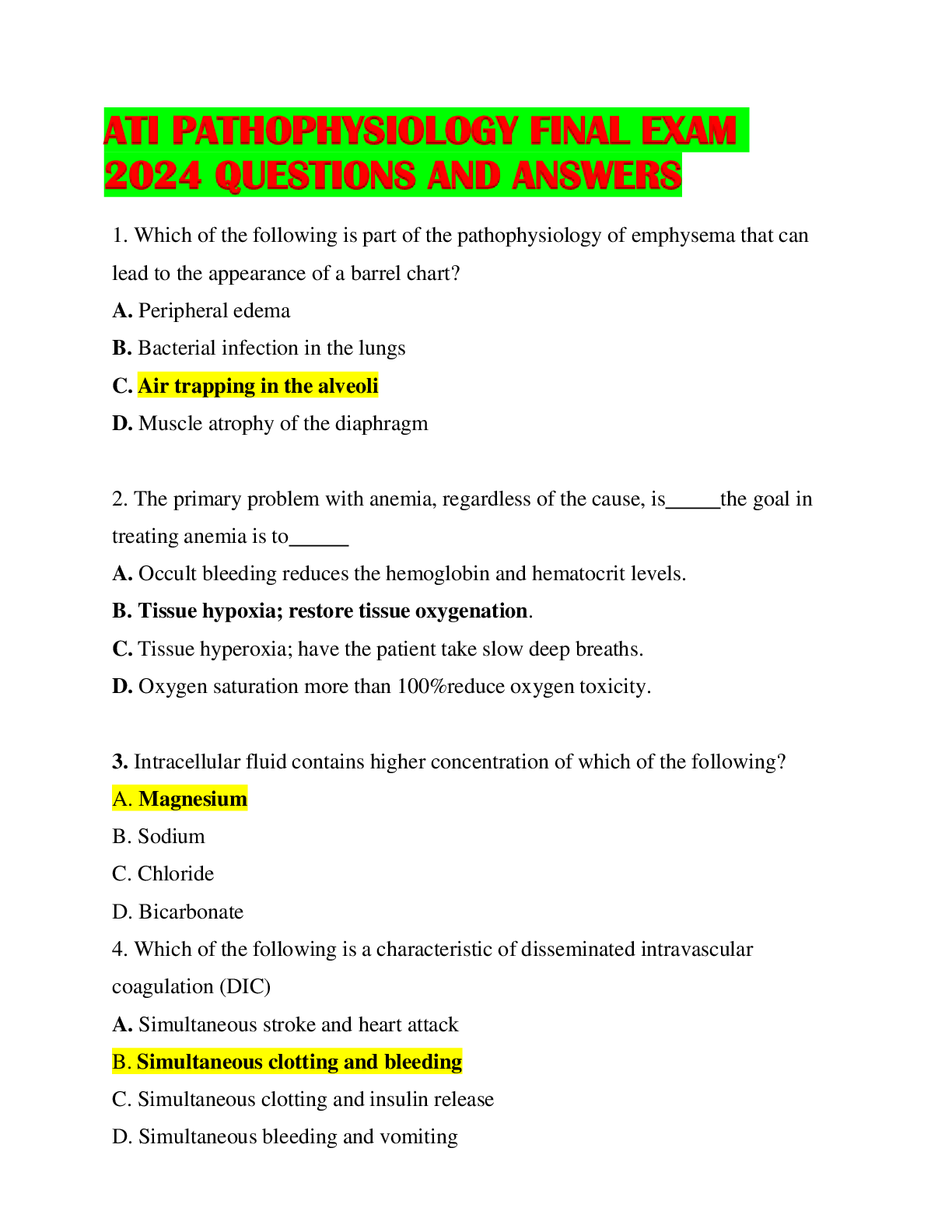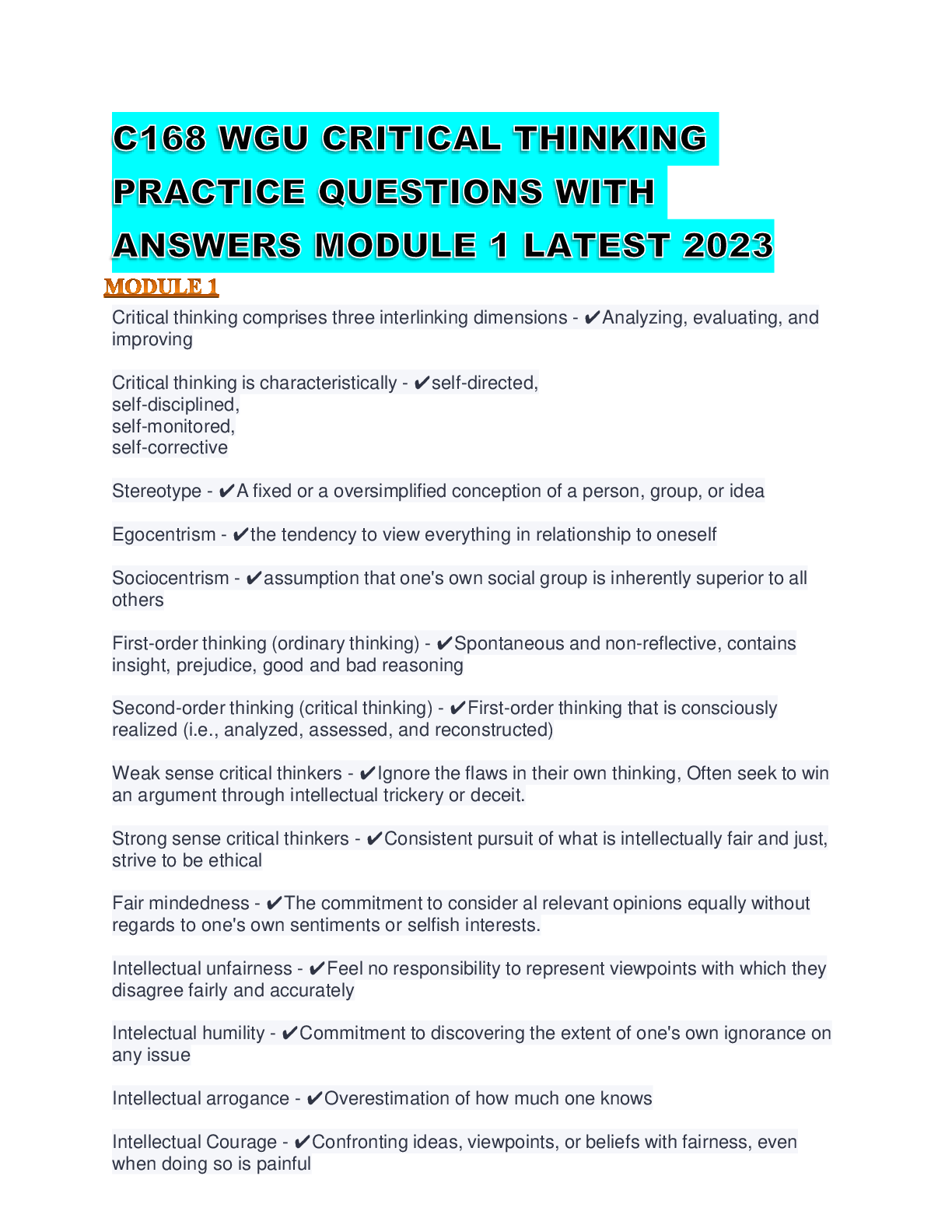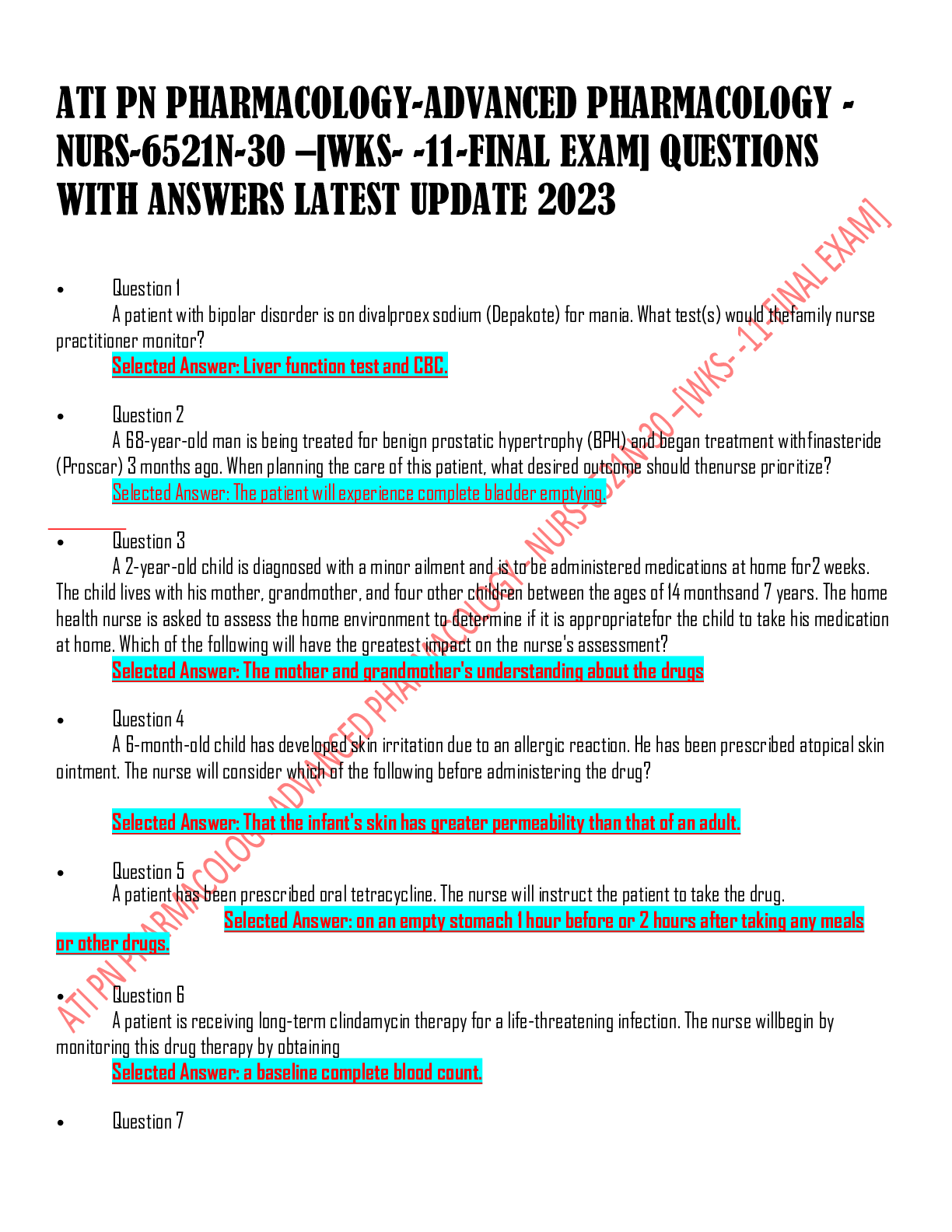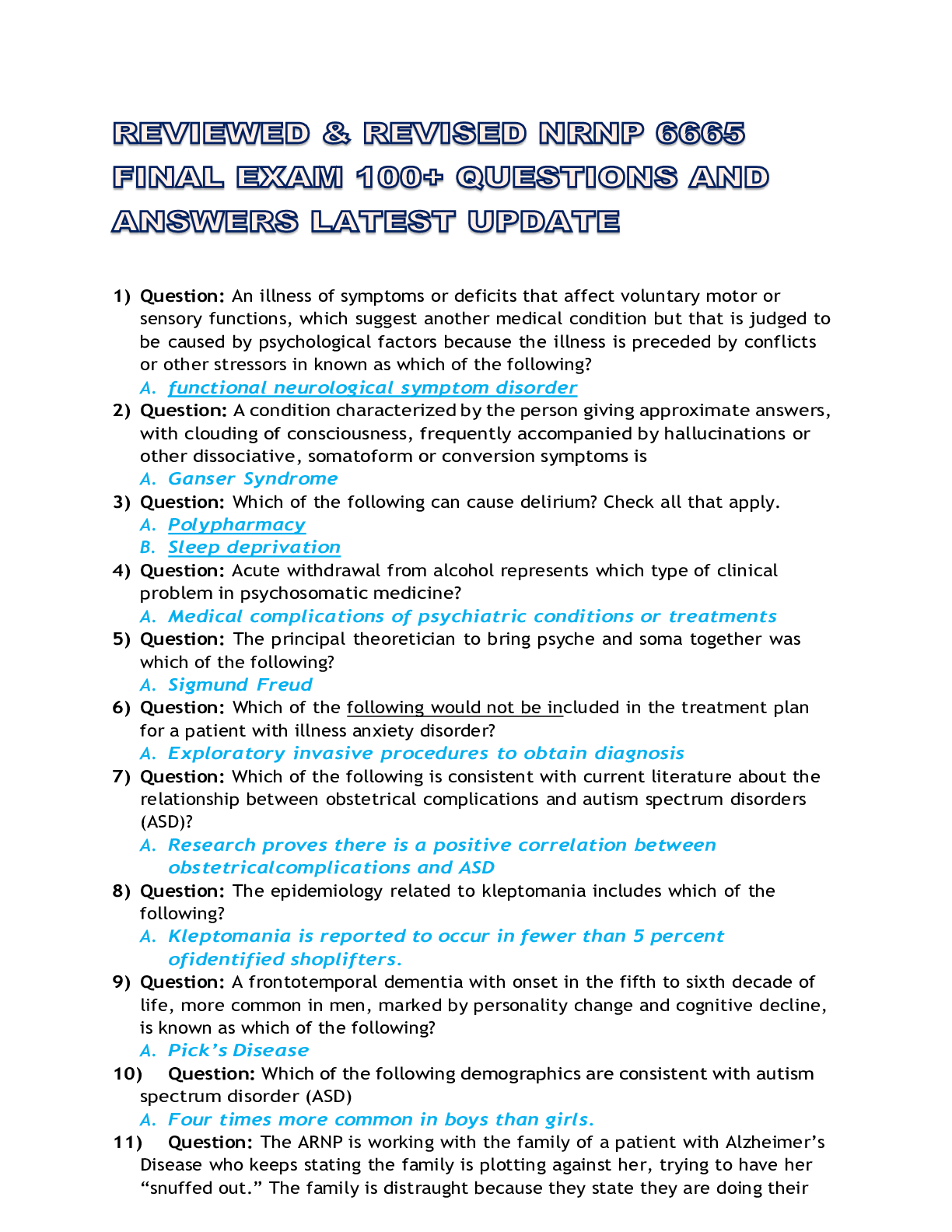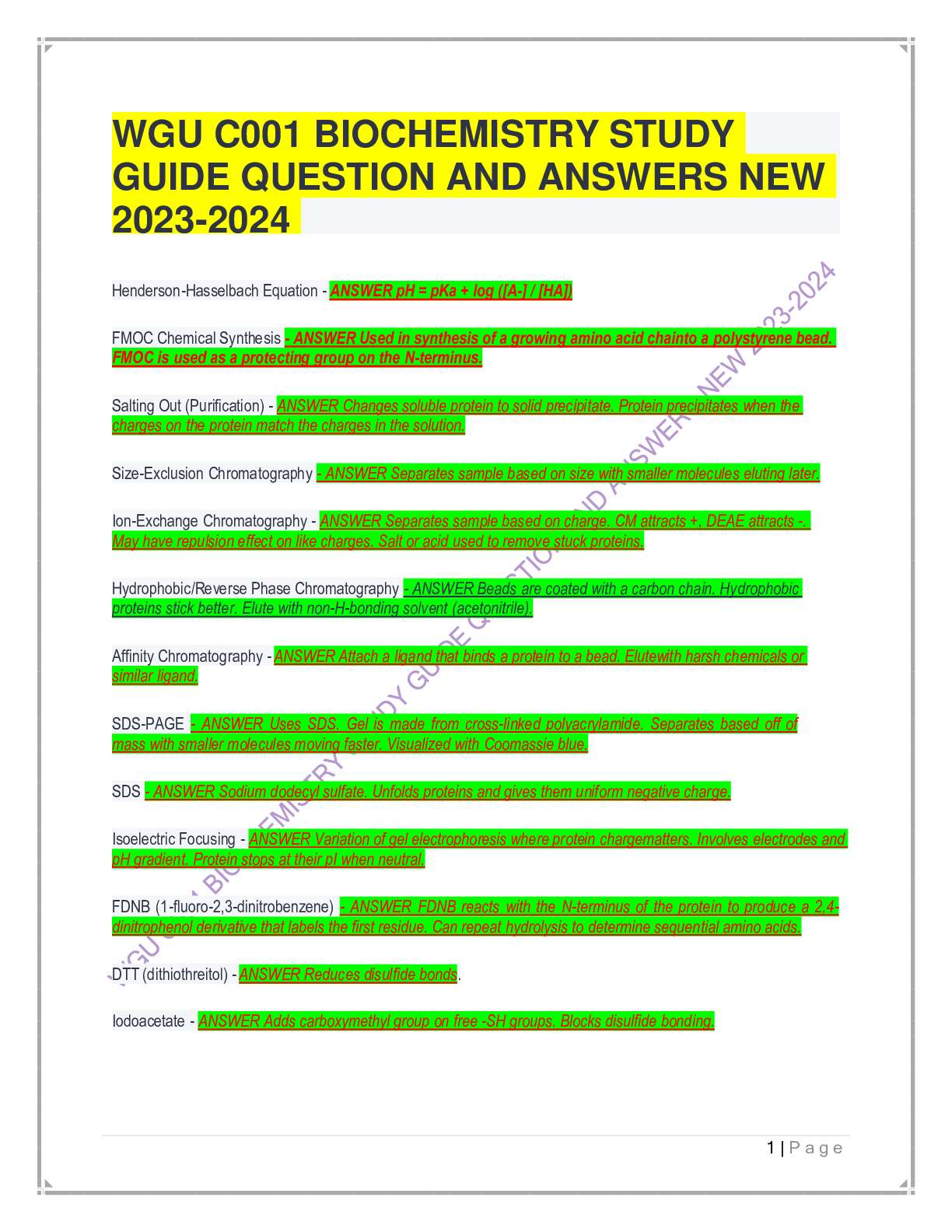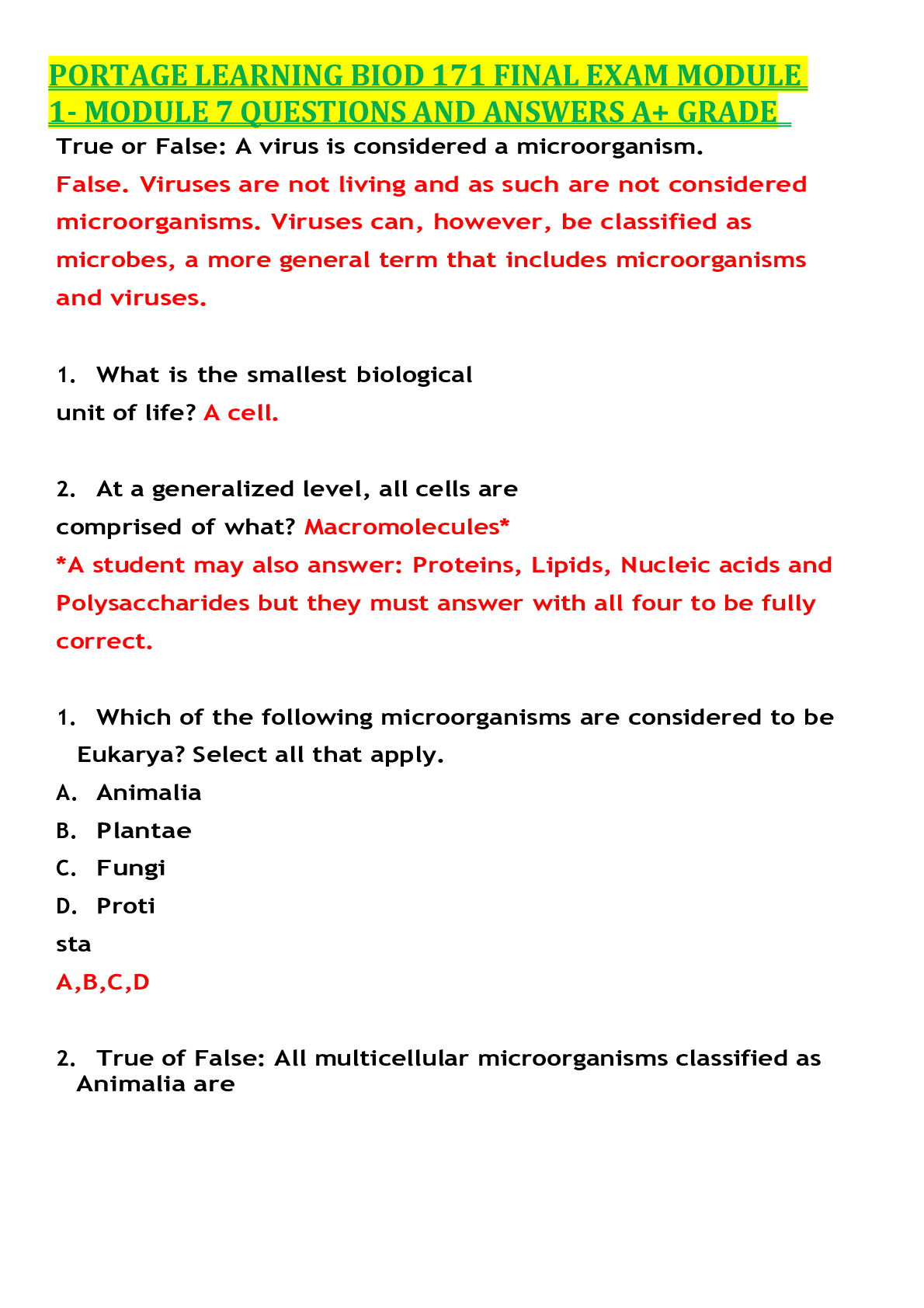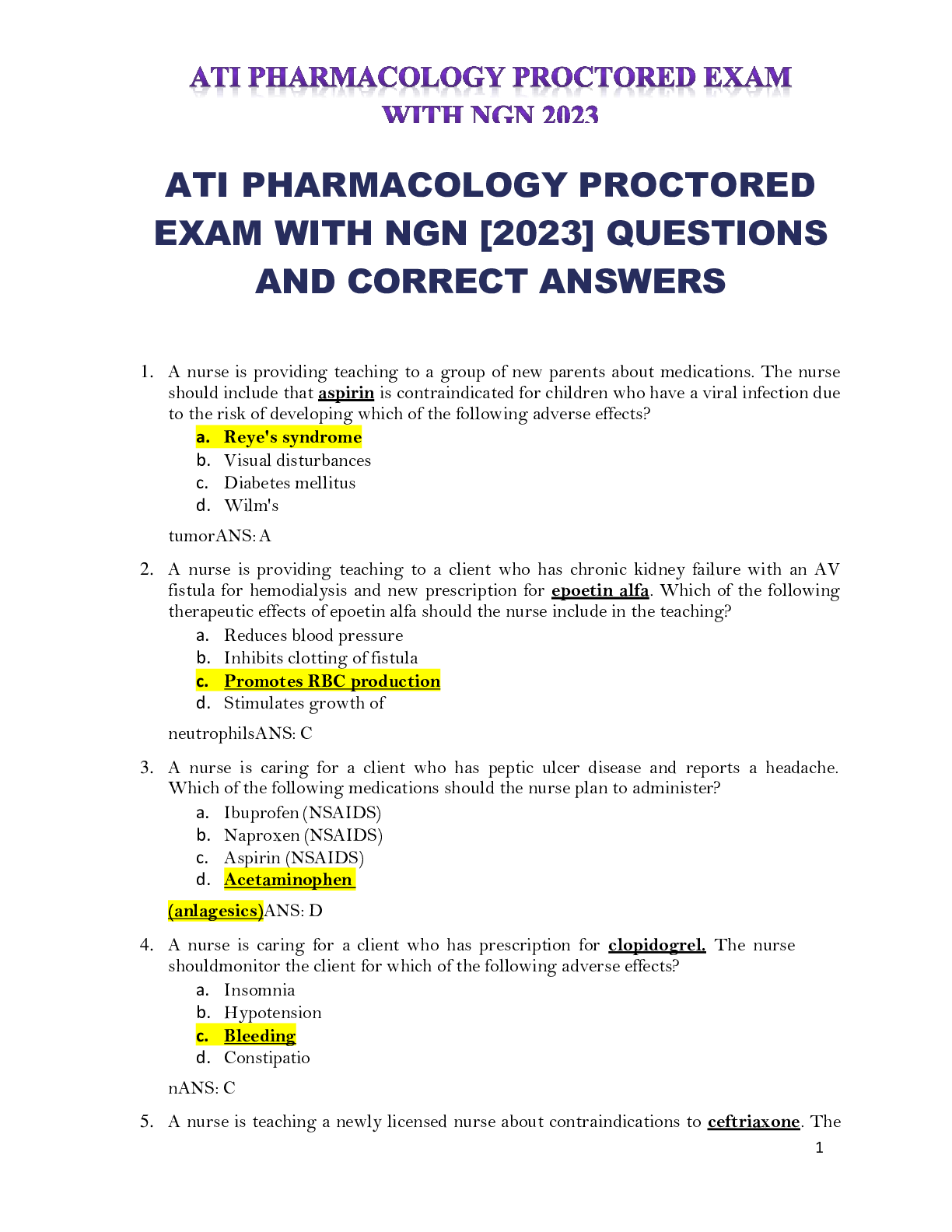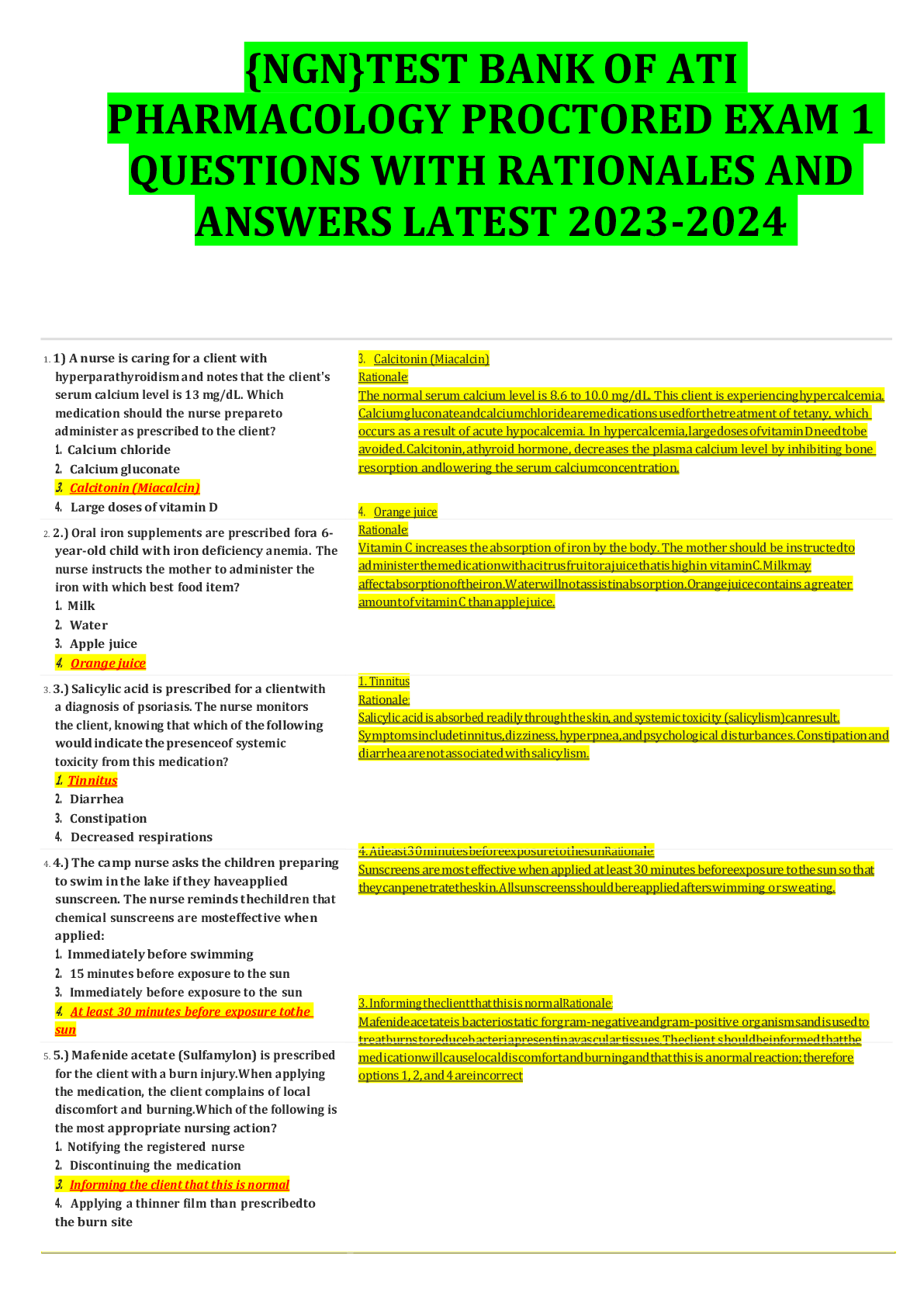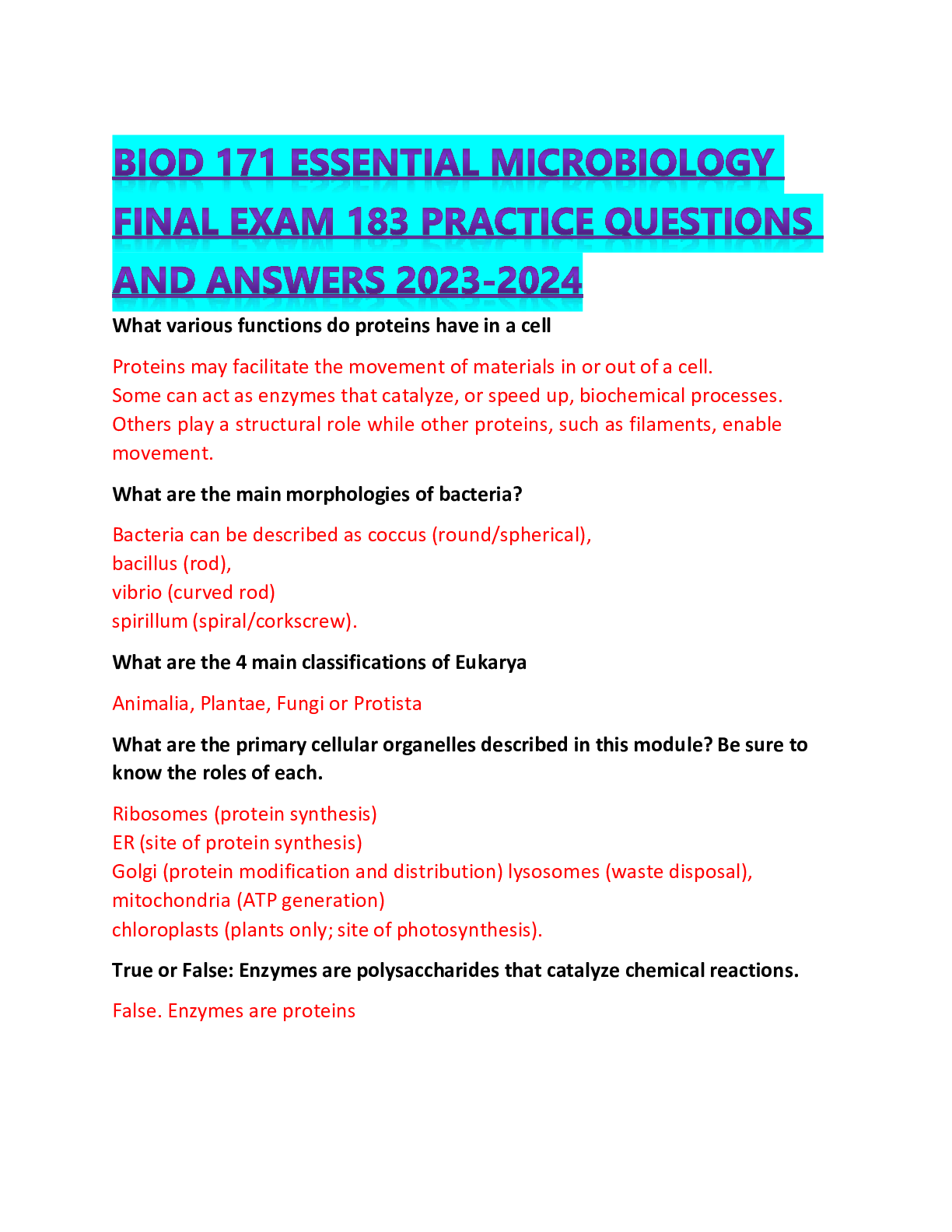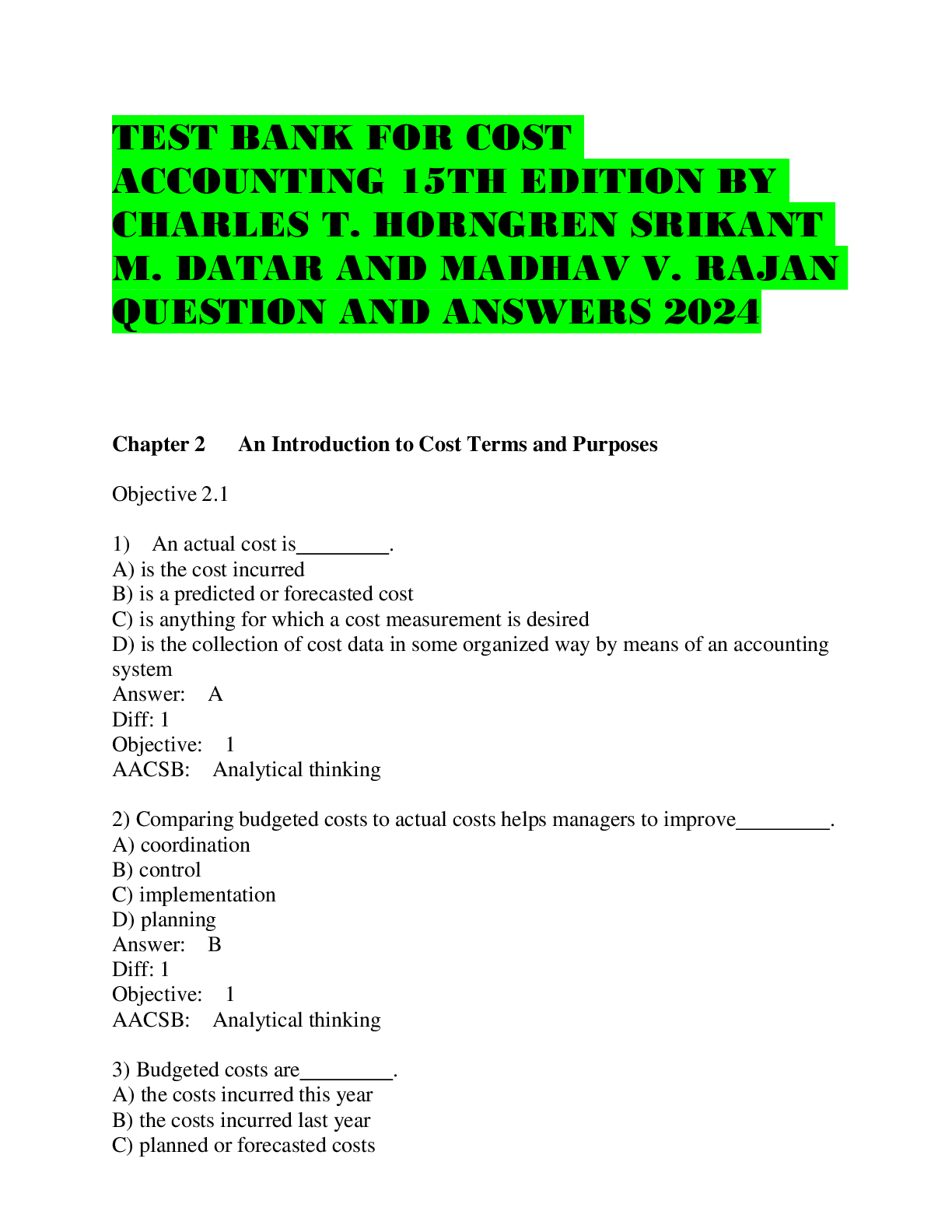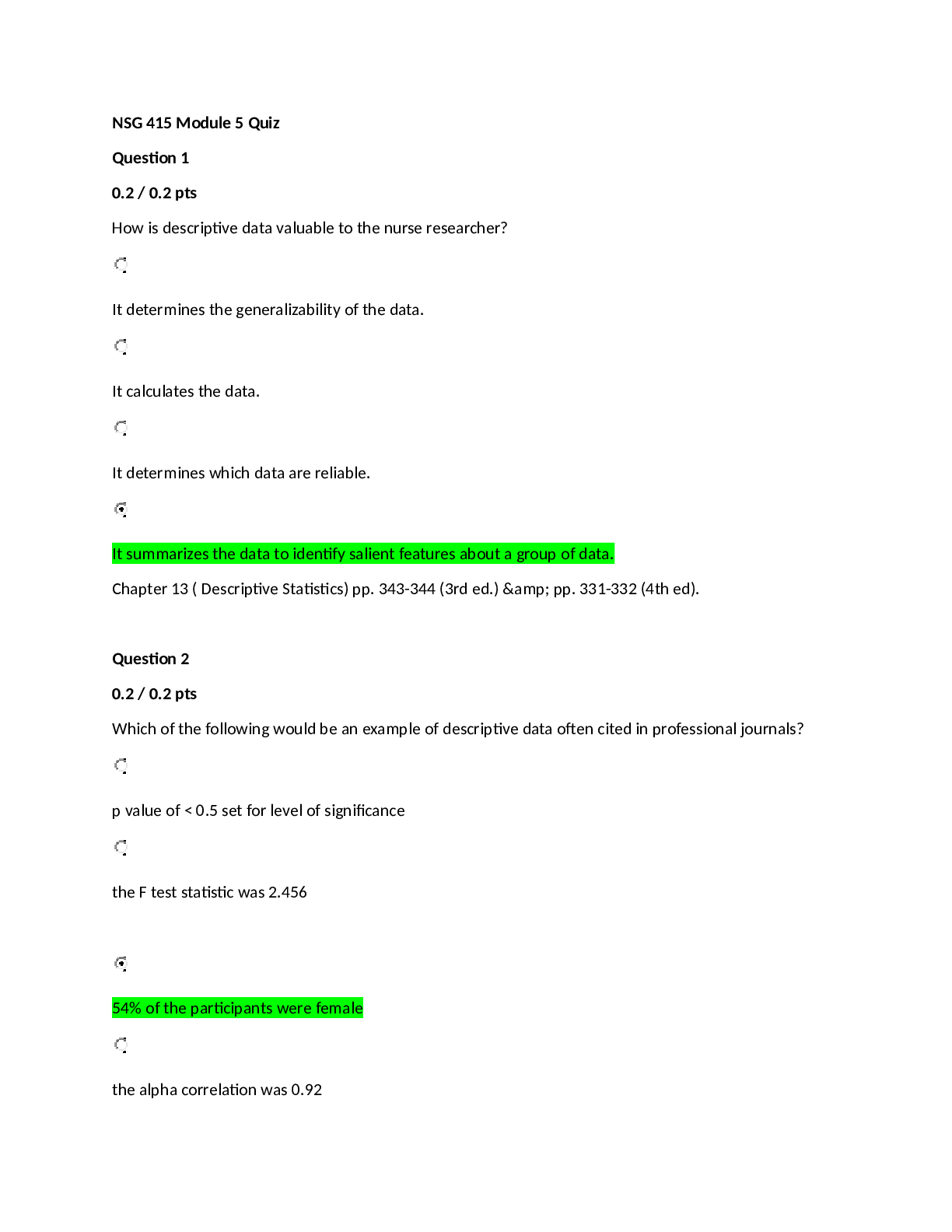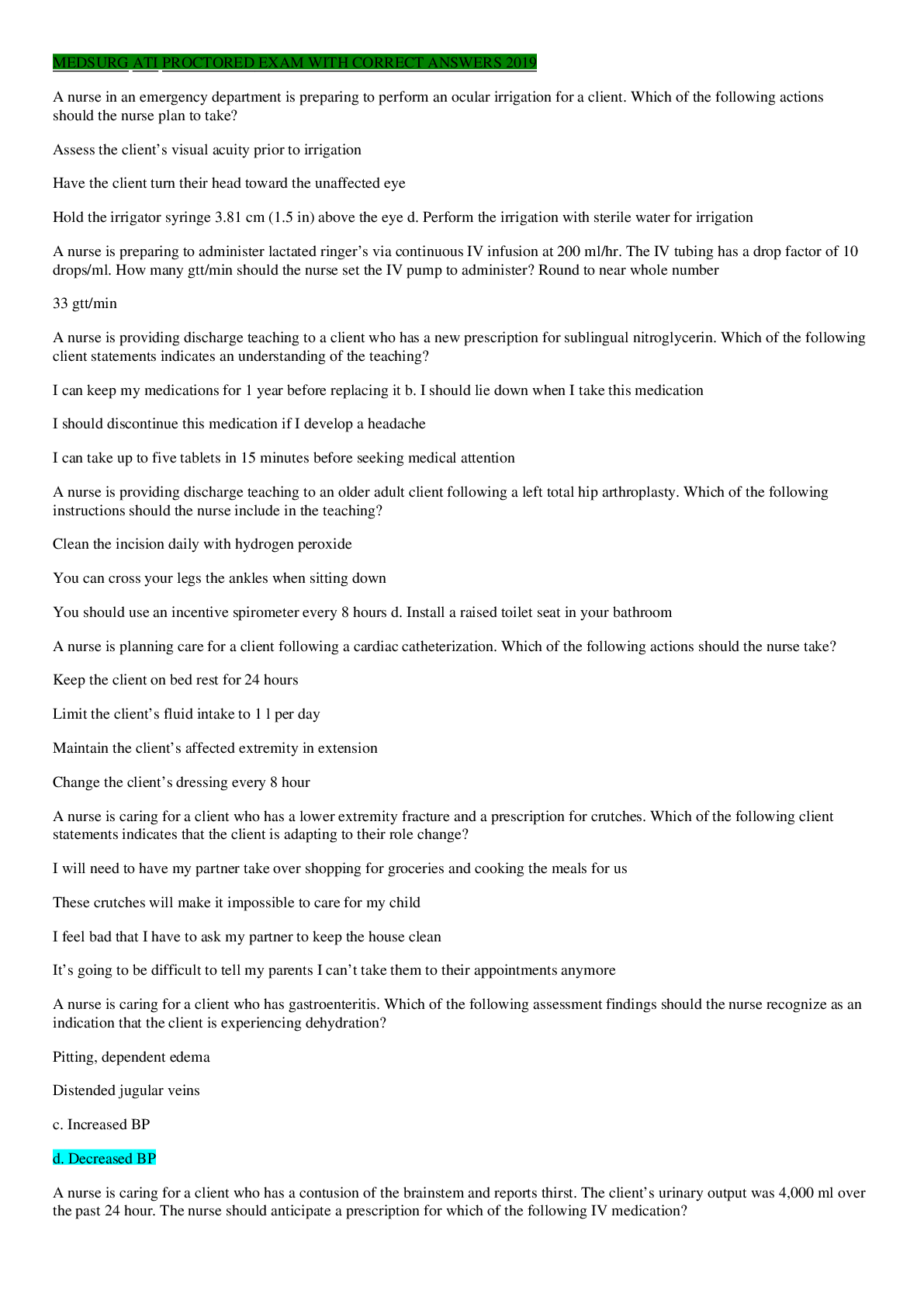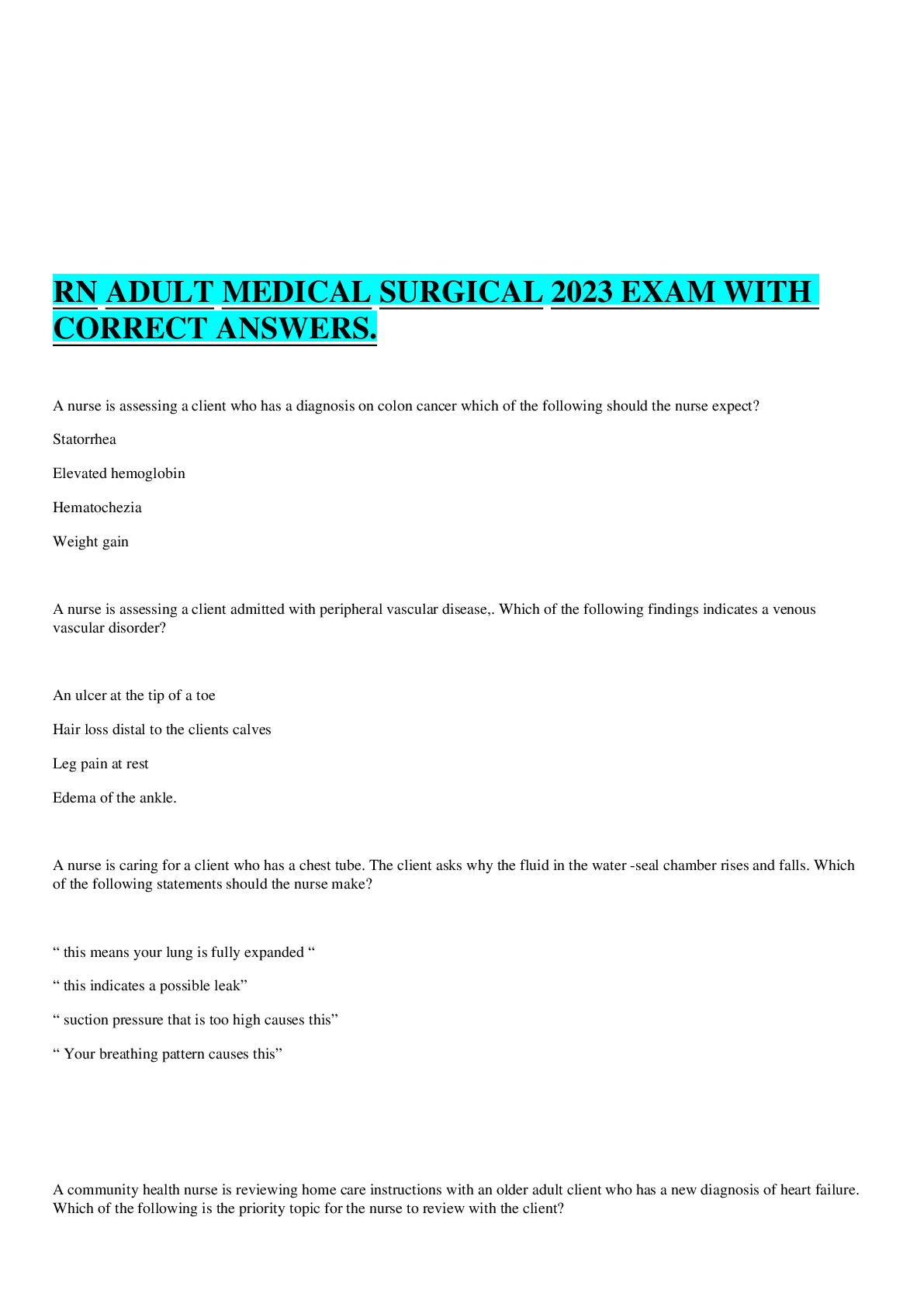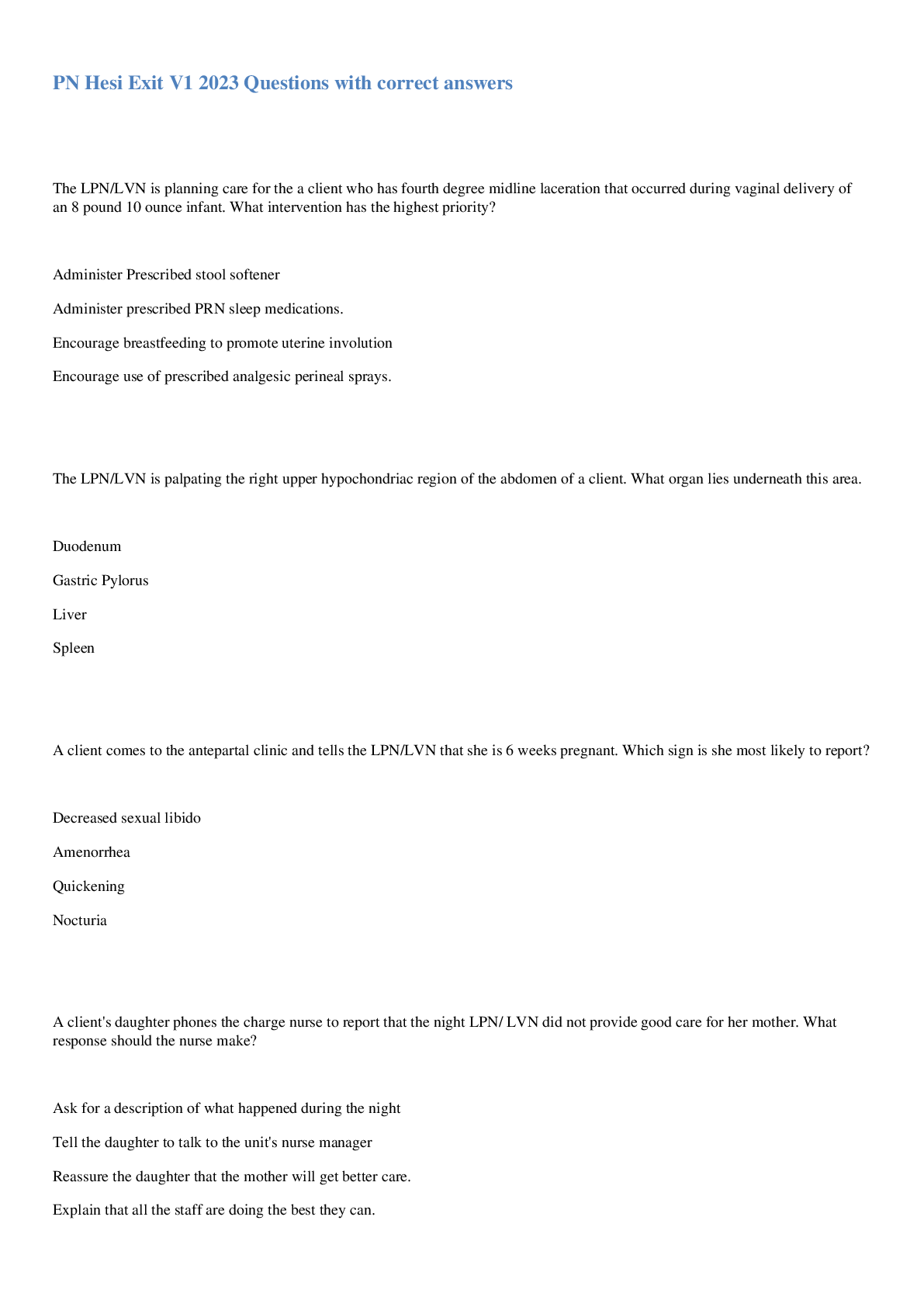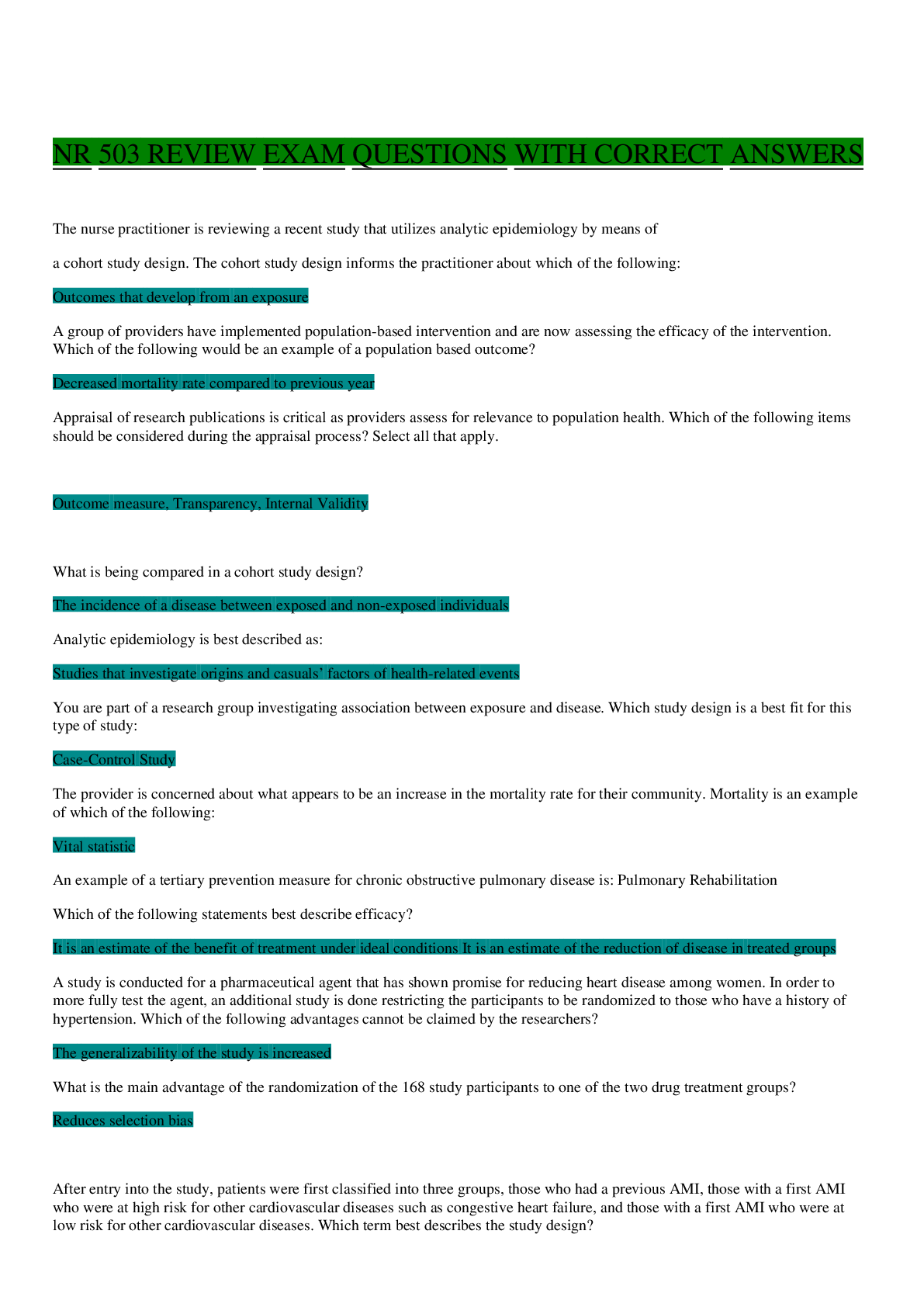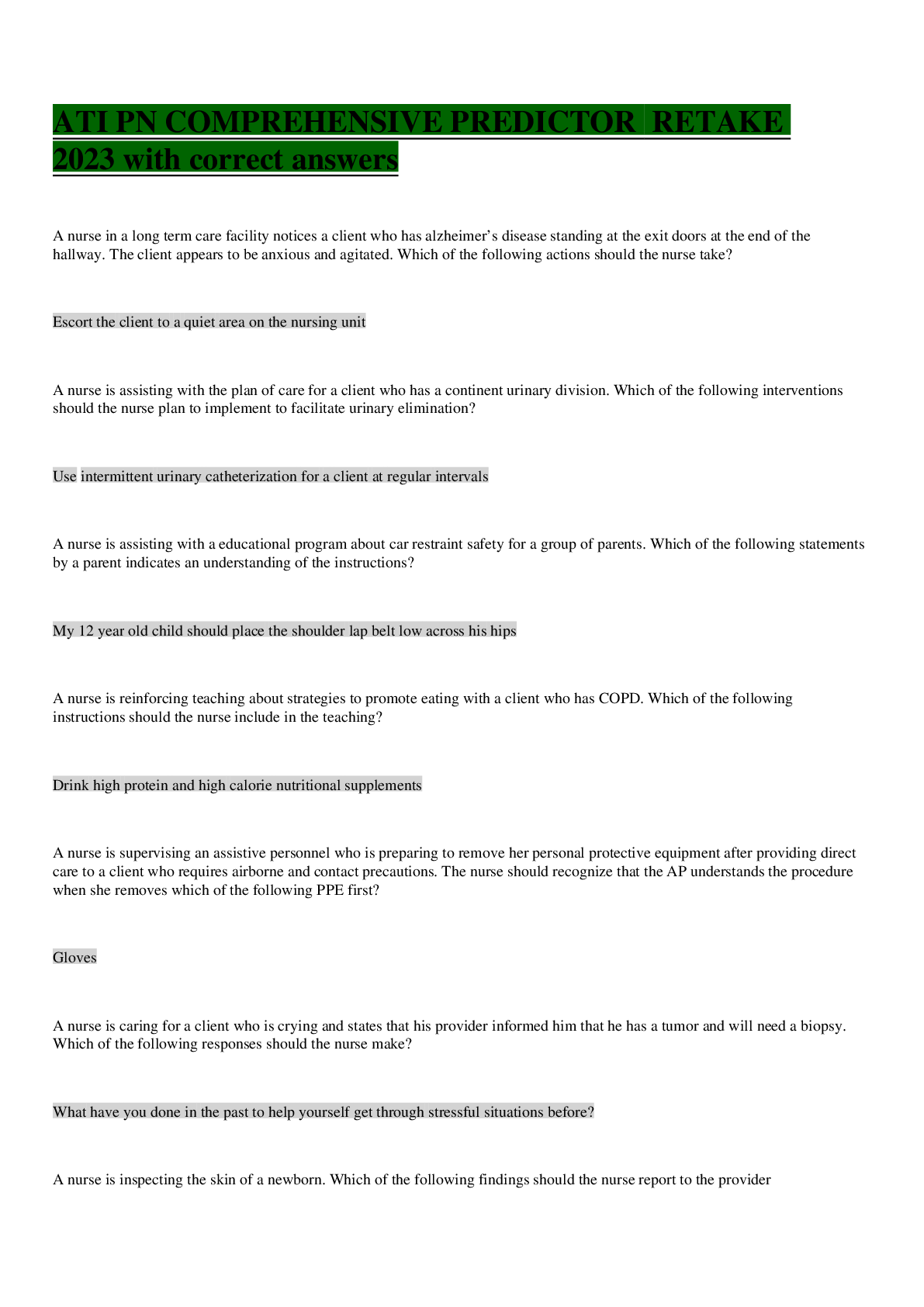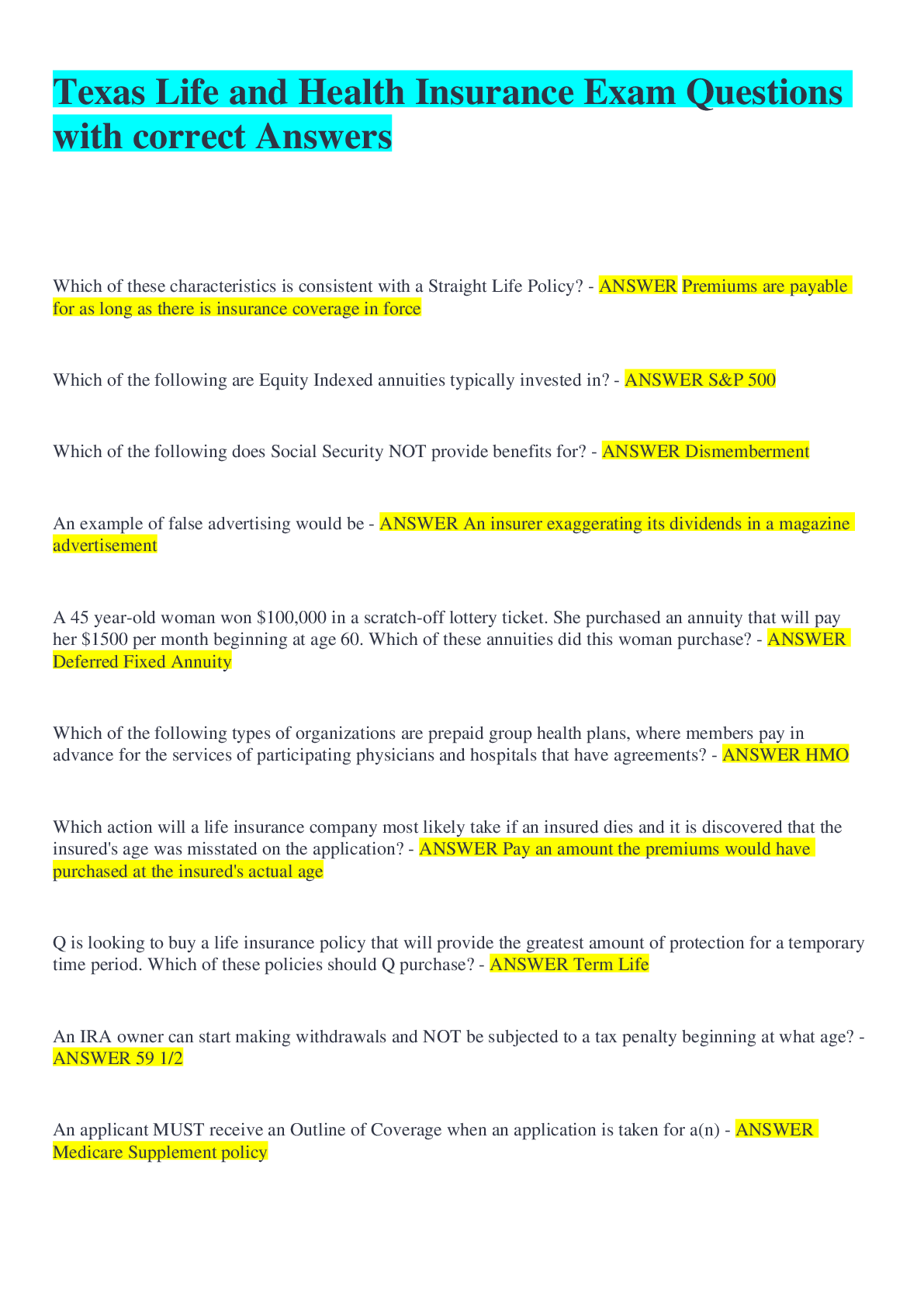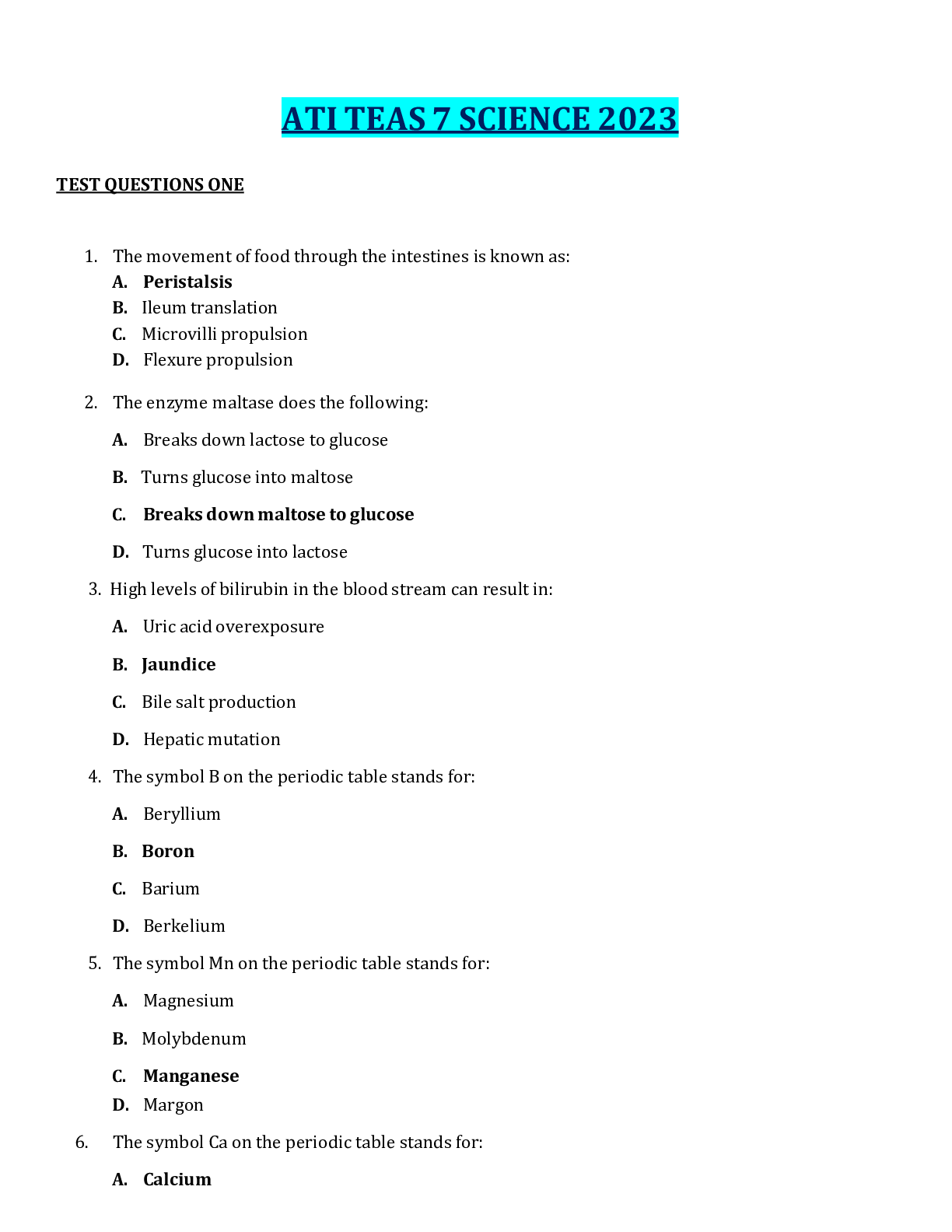Health Care > EXAM > ATI DETAILED ANSWER KEY PRACTICE TEST #2 ATI NURSING 2023-2024 QUESTIONS WITH CORRECT ANSWERS AND RA (All)
ATI DETAILED ANSWER KEY PRACTICE TEST #2 ATI NURSING 2023-2024 QUESTIONS WITH CORRECT ANSWERS AND RATIONALES
Document Content and Description Below
ATI DETAILED ANSWER KEY PRACTICE TEST #2 ATI NURSING 2023-2024 QUESTIONS WITH CORRECT ANSWERS AND RATIONALES 1. A nurse is caring for a client who has congestive heart failure and is taking digox... in daily. The client refusedbreakfastandiscomplainingofnauseaandweakness.Whichofthefollowingactionsshouldthenursetakefirst? A. Check the client's vital signs. Rationale: It is possible that the client's nausea is secondary to digoxin toxicity. By obtaining vital signs, thenurse can assess for bradycardia, which is a symptom of digoxin toxicity. The nurse shouldwithhold the medication and call the provider if the client's heart rate is less than 60 bpm. B. Request a dietitian consult. Rationale:Whilethe dietitian might be able to assist the client with making appropriate food choices, this isnot the first action the nurse should take. C. Suggest that the client rests before eating the meal. Rationale:While this intervention mightbe appropriate, this is not the first action the nurse should take. D. Request an order for an antiemetic. Rationale:Whilethis intervention might relieve the client's nausea,this is not the first action the nurseshould take. 2. A nurse is caring for a clientwho has thrombophlebitis and is receiving heparin by continuous IV infusion.Theclient asks the nurse how long it will take for the heparin to dissolve the clot. Which of the following responsesshould the nurse give? A. "It usually takes heparin at least 2to 3 days to reach a therapeutic blood level." Rationale: The effects of heparin begin within minutes. This response does not accurately answer theclient's question. B. "A pharmacist is the person to answer that question." Rationale:Contacting the pharmacist is not the appropriate answer for the nurse to give. C. "Heparin does not dissolve clots. It stops new clots from forming." Rationale: Thisstatementaccuratelyanswerstheclient'squestion. D. "The oral medication you will take after this IV will dissolve the clot." Rationale: This is not a correct response. Warfarin,a PO medication that is often started after the clienthas been on heparin, does not dissolve clots. 3. A nurse is caring for a client who hasdeep vein thrombosis and has been on heparin continuous infusion for 5days. The provider prescribes warfarin PO without discontinuing the heparin. The client asks the nurse why bothanticoagulants are necessary. Which of the following statements should the nurse make? Page 1 A. "Warfarin takes several days to work, so the IV heparin will be used until the warfarin reaches a therapeuticlevel." Rationale: Heparin and warfarin are both anticoagulants that decrease the clotting ability of the blood andhelp prevent thrombosis formation in the blood vessels. However, these medications work indifferent ways to achieve therapeutic coagulation and must be given together until therapeuticlevels of anticoagulation can be achieved by warfarin alone, which is usually within 1 to 5 days.When the client's PT and INR are within therapeutic range, the heparin can be discontinued. B. "I will call the provider to get a prescription for discontinuing the IV heparin today." Rationale:DiscontinuingtheIVheparinisnotindicatedatthistime. C. "Both heparin and warfarin work together to dissolve the clots." Rationale:Neither medication dissolves clots that have already formed. D. "The IV heparin increases the effects of the warfarin and decreases the length of your hospital stay." Rationale:Neithermedicationincreasestheeffectsoftheother. 4. A nurse caring for a client who has hypertension and asks the nurse about a prescription for propranolol.The nurseshould inform the client that this medication is contraindicated in clients who have a history of which of the followingconditions? A. Asthma Rationale: Propranolol, a beta-blocker, is contraindicated in clients who have asthma because it can causebronchospasms. Propranolol blocks the sympathetic stimulation, which prevents smooth musclerelaxation. B. Glaucoma Rationale: Beta-blockers are contraindicated in clients who have cardiogenic shock, but are notcontraindicated ina client who has glaucoma. C. Depression Rationale: Beta-blockers are contraindicated in clients who have AV heart block, but are notcontraindicated in clients who have depression. D. Migraines Rationale:Beta-blockers are used for prophylactic treatment of migraine headaches. 5. A nurse is preparing to administer verapamil by IV bolus to a client who is having cardiac dysrhythmias. For whichof the following adverse effects should the nurse monitor when giving this medication? A. Hyperthermia Rationale:Temperature is not affected by verapamil. B. Hypotension Rationale:Verapamil, a calcium channel blocker, can be used to control supraventricular tachyarrhythmias. It also decreases blood pressure and acts as a coronary vasodilator and antianginal agent. Amajor adverse effect of verapamil is hypotension; therefore, blood pressure and pulse must bemonitored before and during parenteral administration. C. Ototoxicity Rationale:Verapamil is not toxic to the ear. D. Muscle pain Rationale:Verapamil does not cause muscle pain. 6. A nurse is caring for a client who is taking lisinopril. Which of the following outcomes indicates a therapeutic effectof the medication? A. Decreased blood pressure Rationale: Lisinopril, an ACE inhibitor, may be used alone or in combination with other antihypertensives inthe management of hypertension and congestive heart failure.A therapeutic effect of themedication is a decrease in blood pressure. B. Increase of HDL cholesterol Rationale:This is not an intended effect of lisinopril. C. Prevention of bipolar manic episodes Rationale:This is not an intended effect of lisinopril. D. Improved sexual function Rationale: This is not an intended effect of lisinopril. Lisinopril may in fact cause sexual dysfunction andimpotence. 7. A nurse is caring for a client who has heart failure and a prescription fordigoxin. Which of the following statementsby the client indicates an adverse effect of the medication? A. "I can walk a mile a day." Rationale:Improving the client's cardiac output,which in turn will improvethe client's exercise tolerance, isa therapeutic response to digoxin. B. "I've had a backache for several days." Rationale:Backaches are not an adverse effect of digoxin. C. "I am urinating more frequently." Rationale: Improving the client's cardiac output, which in turn will increase blood flow to the kidneys andurination, is a therapeutic response to digoxin. D. "I feel nauseated and have no appetite." Rationale:Anorexia, nausea, vomiting, and abdominal discomfort are early signs of digoxin toxicity. 8. A nurse is caring for a client who has a new prescription for ferrous sulfate tablets twice daily for iron- deficiencyanemia. The client asks the nurse why the provider instructed that she take the ferrous sulfate between meals.Which of the following responses should the nurse make? A. "Taking the medication between meals will help you avoid becoming constipated." Rationale: Taking the medication with food can reduce the GI symptoms associated with it. However,taking the medication between meals maximizes absorption. B. "Taking the medication with food increases the risk of esophagitis." Rationale:Reclining immediately after taking ferrous sulfate maylead to esophageal corrosion. Clientsshould remain upright for 15-30 min following administering. C. "Taking the medication between meals will help you absorb the medication more efficiently." Rationale:Ferrous sulfate provides the iron needed by the body toproduce red blood cells. Taking ironsupplements between meals helps to increase the bioavailability of the iron. D. "The medication can cause nausea if taken with food." Rationale: Taking ferrous sulfate with food can reduce the GI symptoms associated with it. However, takingthe medication between meals maximizes absorption. 9. A nurse is caring for a client who has chronic renal disease and is receiving therapy with epoetin alfa.Which of thefollowing laboratory results should the nurse review for an indication of a therapeutic effect of the medication? A. The leukocyte count Rationale:Epoetin alfa does not affect the leukocyte, or WBC, count. B. The platelet count Rationale:An increase in platelets is not the therapeutic or desired effect of epoetin alfa. C. The hematocrit (Hct) Rationale: Epoetin alfa is an antianemic medication that is indicated in the treatment of clients who haveanemia due to reduced production of endogenous erythropoietin, which may occur in clients whohaveend- stagerenaldiseaseormyelosuppressionfromchemotherapy.Thetherapeuticeffectof epoetin alfa is enhanced red blood cell production, which is reflected in an increased RBC,Hgb, and Hct. D. The erythrocyte sedimentation rate (ESR) Rationale: [Show More]
Last updated: 2 months ago
Preview 1 out of 55 pages
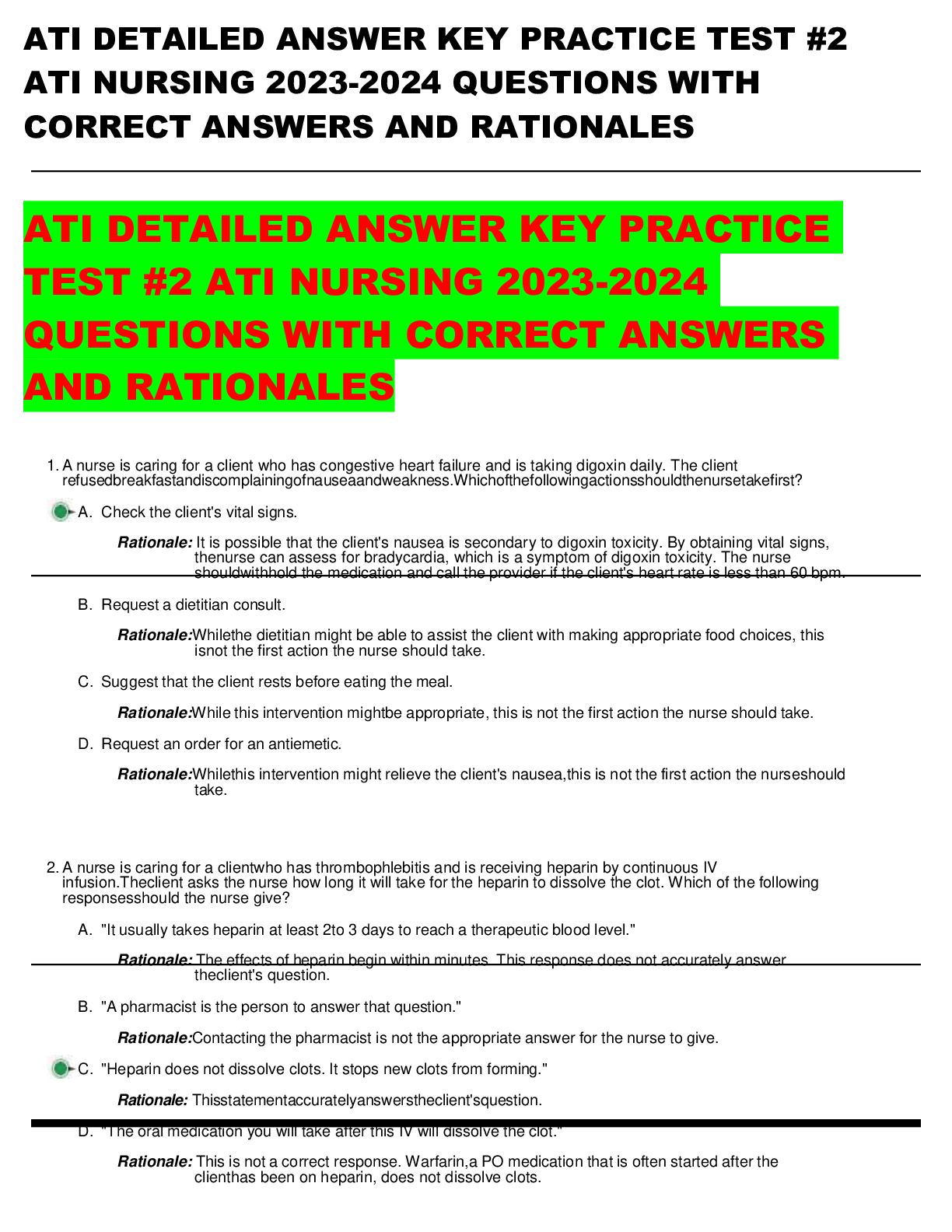
Reviews( 0 )
Document information
Connected school, study & course
About the document
Uploaded On
Feb 17, 2024
Number of pages
55
Written in
Additional information
This document has been written for:
Uploaded
Feb 17, 2024
Downloads
0
Views
17

